If you’re a relatively new pianist, just figuring out how to navigate the piano keys can be tough. So when you think about learning piano theory, it’s easy to get overwhelmed. But if you give it a chance, you’ll find that even a passing familiarity with piano music theory can improve your playing and help the piano make sense.
Piano Music Theory: an Introduction
It’s also a lot easier to learn music theory if you do it bit by bit. It’s also easier to retain concepts if you apply them as soon as you learn them. Our list is designed to be a general introduction to some of the most important music theory concepts for beginners — you don’t need to commit everything to memory the first time you read it!
What’s The Point Of Learning Music Theory?
The idea of learning theory isn’t all that appealing to many piano students. Though it has a reputation of being boring or overly complex, the piano theory is really just about how music works.
You don’t need to do a very in-depth study or spend countless hours per week delving into piano theory. But a working knowledge of basic music theory (and specifically piano theory) will help improve your sound. For one, it can help you be more creative — when you understand how scales and keys work, you’ll be able to improvise.
Understanding piano theory will also help you see the structure of the music you play. Seeing the structure lets you get the bigger picture, which in turn makes you play and sound better! For a little more information on how learning theory can help you, check out this informative video.
Beginning Piano Theory: Note Names & the Staff
If you’ve ever taken a look at piano sheet music, you probably noticed that there are two staff. The top staff is headed by a treble clef. It contains the higher-pitched notes that are usually played by your right hand. The bottom staff is headed by a bass clef. It contains the lower-pitched notes that are usually played by your left hand. The note values are determined by where the notes are on either staff. Here’s a quick look:
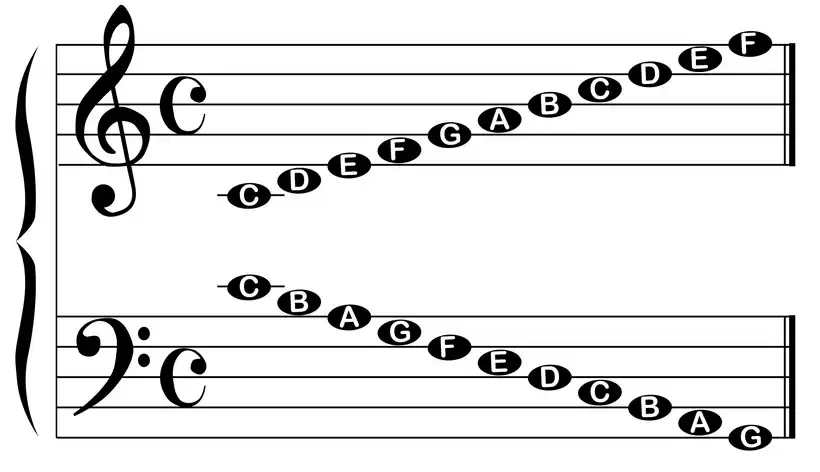
But what do the note names mean? Part of music fundamentals is understanding the musical alphabet. In Western music, there is a seven-note musical alphabet: A, B, C, D, E, F, G. (In the next section, we’ll talk about the sharp/flat values in between letters.). Here’s a detailed graphic of the piano keyboard with all the notes labeled:
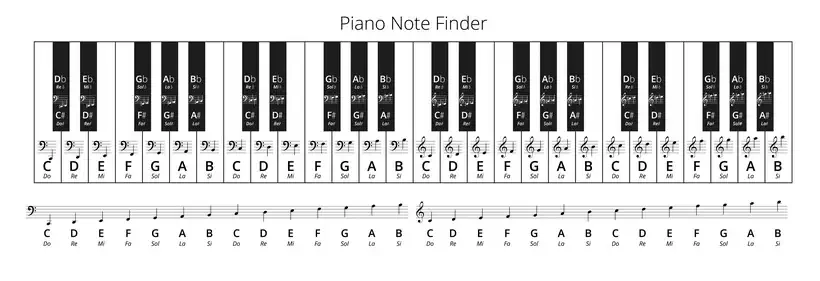
Across the piano, that musical alphabet repeats itself every eight keys. Each set of eight white keys is known as an octave. If you want to learn more about reading music for the piano, check out this helpful video.
Steps and the Black Keys
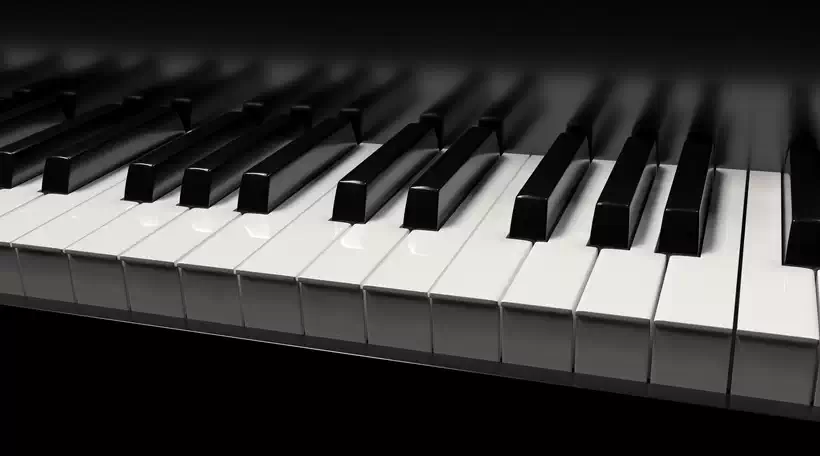
We mentioned above that octaves are made of sets of white keys. So what are the black keys? They are known as “accidentals.” If a black key is immediate to the right of a white key, it is the sharp version of that note. If the black key is immediate to the left of a white key, it is the flat version of that note:
You may have noticed that the black keys can have two note names; for example, the leftmost black key is either C# or D♭. The notes are enharmonic, meaning that C# and D♭ are two names for the exact same note.
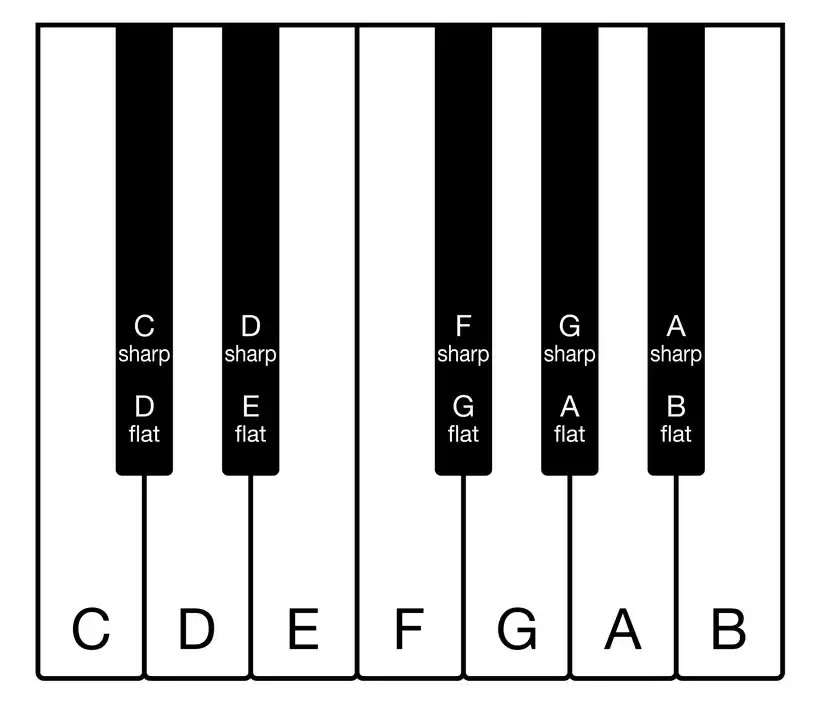
You probably also saw in the picture that some white keys do not have a black key between them. That’s because in the musical alphabet, some notes do not have sharp values. Here’s the musical alphabet with sharp/flat values included:
A A#/B♭ B C C#/D♭ D D#/E♭ E F F#/G♭ G G#/A♭
There’s no such thing as an E# or B#! The distance between each note above is a semitone, commonly called a half step. This is the smallest interval in Western music.
The distance between the two notes above is a whole step. For example, in going from A to A#, we move a half-step up. In moving from A to B, we move a whole step. It’s easy to visualize whole and half steps on the piano keyboard: moving a half step means moving one key over while moving a whole step means moving two keys over. This includes black keys!
Steps are some of the crucial building blocks of music. When you’re learning basic music theory, you will use whole steps and half steps often. (We will revisit the whole and half steps in the section on scales). For now, check out this video on whole steps and half steps.
Understanding Rest and Rhythm
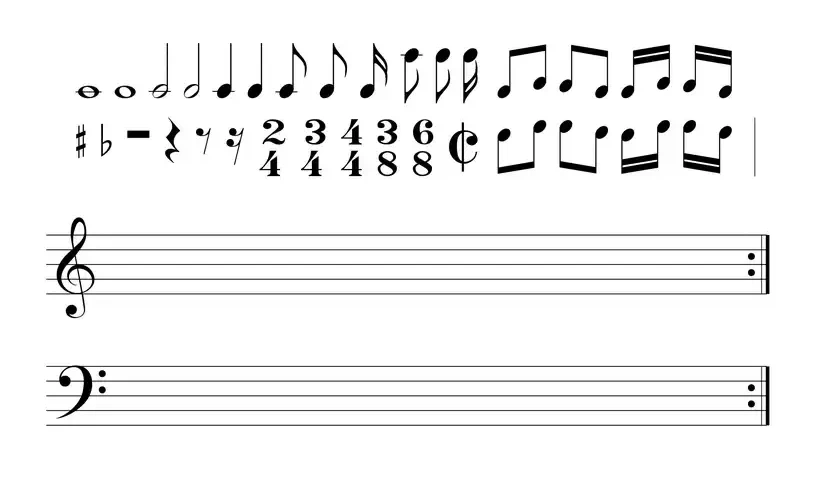
One of the most important parts of learning music theory is being able to read the notes and rests in sheet music. Writing and deciphering melodic lines will be significantly easier when you can read piano music in standard notation. Two of the most important parts of standard notation are notes and rests. Notes and rests follow a similar pattern:
Whole notes are four beats, half notes are two beats, and quarter notes are one beat. The eighth notes are a half beat and the sixteenth note are a quarter beat. Each type of note has a corresponding rest value as shown above. How beats are grouped depends on a piece’s time signature.
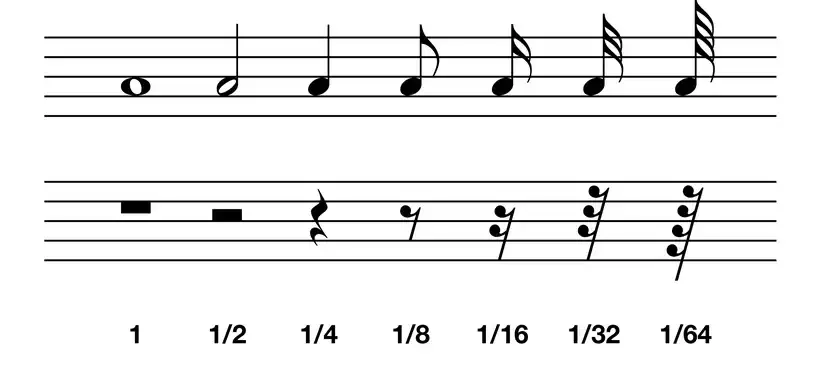
In a time signature, the top number tells you how many beats are in a measure. The bottom number helps you get an idea of how to count the beats.
Of course, this is just a broad overview of some of the key parts of reading music. For a more thorough introduction to reading piano music, check out this helpful video.
Mastering Scales
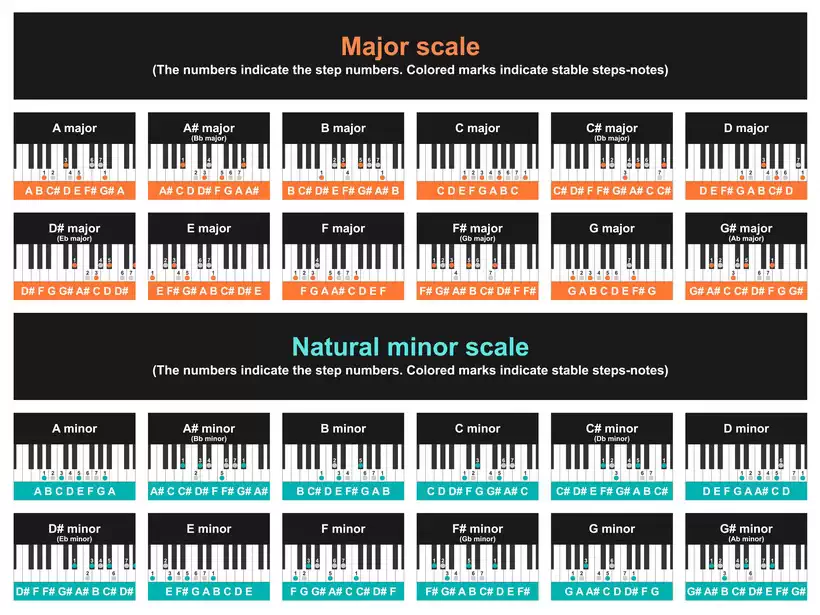
Having some knowledge of major and minor scales is crucial if you want to be a well-rounded pianist. After all, scales are another example of some of the basic building blocks of music. Most piano students start out with the C major scale, as it has no sharps or flats and can be played entirely on the white keys:
But did you know that there’s actually a formula for figuring out major scales and minor scales? It relies on the concepts of whole steps and half steps we talked about above. For a major scale, follow the pattern of whole step-whole step-half step-whole step-whole step-whole step-half step, or WWHWWWH. For a minor scale (specifically, for the natural minor scale) you follow the pattern of WHWWHWW.

As an example, let’s deduce the G major scale. Your root note is G, so it’s the first note in the scale. If we follow the pattern of whole and half steps for the major scale, we get this:
G A B C D E F# G
That’s the G major scale!
Now, we can use the other formula to figure out the G natural minor scale:
G A B♭ C D E♭ F
Most piano teachers will recommend learning all of your major scales and natural minor scales. Learning and practicing major and minor scales goes beyond learning piano theory — as you practice playing scales, you build finger strength, speed, and dexterity. For some advice on practicing your scales, take a look at this video.
Begin to Build Chords
The major and minor scales we talked about above can be used to build chords. Chords are based on intervals, or set distances between notes. The construction of chords is an especially important part of the piano theory.
You’ll hear the phrase “major triad” mentioned a lot. A major tried is just a three-note chord that is made up of a root note, a major third, and a perfect fifth.
For example, you can figure out a C major triad based on the C major scale:
C D E F G A B
The intervals in this case are somewhat self-explanatory. The major third is the third note on a major scale, and the perfect fifth is the fifth note. Our root note is C, so our C major chord is made of C, E, and G.
Chances are good that minor chords that you learn as a beginning piano student will be minor triads. The intervals of a minor triad are the root note, a flattened (minor) third, and a perfect fifth. The flattened third is what gives a minor chord its signature “sad” sound.
To get the C minor triad, we just need to “flatten” the third of the C major scale. The other two notes are the same. So our C minor chord is made of C, E♭, and G. As you can see, though minor and major chords sound very different, their actual construction is fairly similar.
This is just an intro to some of the most basic piano chords. You’ll likely also learn about diminished chords and seventh chords early on.
Chord inversions are another concept in piano theory that you may learn about later. A chord inversion is a chord that uses the same notes as the parent chord, but it changes which note is the lowest in the chord.
As you become familiar with basic chords, you’ll start to work on chord progressions (check out some common chord progressions for beginners here).
If you write your own music, you’ll find that chord progressions can really make or break your musical compositions.
We’ll delve more into building chord progressions at another time, but one of the most important parts of a chord progression is making sure the chords are all in the same key.
Understanding Keys
Time signatures and key signatures are two of the first things you’ll see when looking at sheet music. And part of basic music theory is understanding what a key is in music.
Basically, the key of a piece of music is the major or minor scale it’s based on. The notes of that scale are considered to be “in-key.” A piece of music will often contain some notes outside of its key, but most are likely to be in-key. So songs in major keys will generally be mostly made up of the notes in the relevant major scale.
As you develop as a pianist, you’ll likely learn how to use the key signature of a piece of music to tell what key it’s in. The key signature is immediate to the left of the time signature, and it shows you which notes are sharp, flat, or natural.
Many pieces designed for new music students are in the key of C. That’s because when you look at the key signature, there are no sharps or flats. The lack of sharps or flats makes the piece easier for newer students to navigate. For some more info on key signatures, check out this video.
Understanding keys makes it a lot easier to play with other musicians. This is especially true if you play with a singer. Often, the voice leading the group will have a limited range. If the singer, you, and the other instruments can agree on a key, you’ll be able to play together and still sound good.
Need a Little Help?
Whether it’s trouble figuring out key signatures, difficulty with scales, or simply not knowing what to learn next, challenges are bound to pop up for newer piano students. That’s where piano learning sites come in.
These sites are designed to help piano students of all abilities follow a structured learning plan. There’s a lesson for nearly every theory concept, and there are even courses on songwriting and creating melodies. Many of these sites even offer limited free lessons so you can try them out before you commit!
Final Thoughts
Hopefully, you now have a grasp of piano music theory and how it can help you grow as a musician. Remember to take your time with each concept — it’s more important to be able to apply and work with music theory concepts than it is to just memorize them.
Are there any important music theory concepts we left out? Let us know in the comments, and please don’t forget to like and share if you found our list useful!
